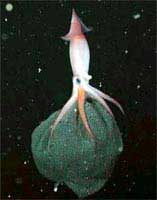A species of squid has been discovered carrying hundreds of eggs in its arms. This is the first known squid species that cares for its offspring after laying eggs.
 Typically, squids release their eggs onto the ocean floor and leave them to fend for themselves. However, scientists have captured footage of the Gonatus onyx squid caring for its clutch of eggs.
Typically, squids release their eggs onto the ocean floor and leave them to fend for themselves. However, scientists have captured footage of the Gonatus onyx squid caring for its clutch of eggs.
Biologist Brad Seibel at the University of Rhode Island, USA, raised questions when, in 1995, he and his colleagues caught both a squid and its clutch of eggs in a single net haul. A year later, he captured another squid along with many baby squids in the same net. This led him and his colleagues to hypothesize that the squid might care for its egg sac until the eggs hatched.
In collaboration with Bruce Robison and Steven Haddock at the Monterey Bay Aquarium Research Institute in California, USA, Seibel recorded images of the mother squid protecting its young at a depth of 2,500 meters.
After five years of observation, the team discovered five female squids carrying sacs of 2,000 to 3,000 eggs. They embraced their egg sacs with two rows of hooks located under three of their four pairs of arms. The egg sac consists of two thin membranes forming an open-ended tube. The squid waves its arms to allow water to flow through, aerating the eggs.
Previously, it was believed that squids could not carry eggs because species often become quickly exhausted after laying them. Most squids tend to become limp as their muscles weaken post-laying and die shortly thereafter.
However, this species appears to be quite robust after laying eggs. Nevertheless, the mother squid gradually weakens as the eggs grow larger, as it cannot feed while nurturing its offspring. The team believes that the mother will carry the eggs in this manner for 6 to 9 months until the eggs hatch, at which point she will be completely exhausted.


















































